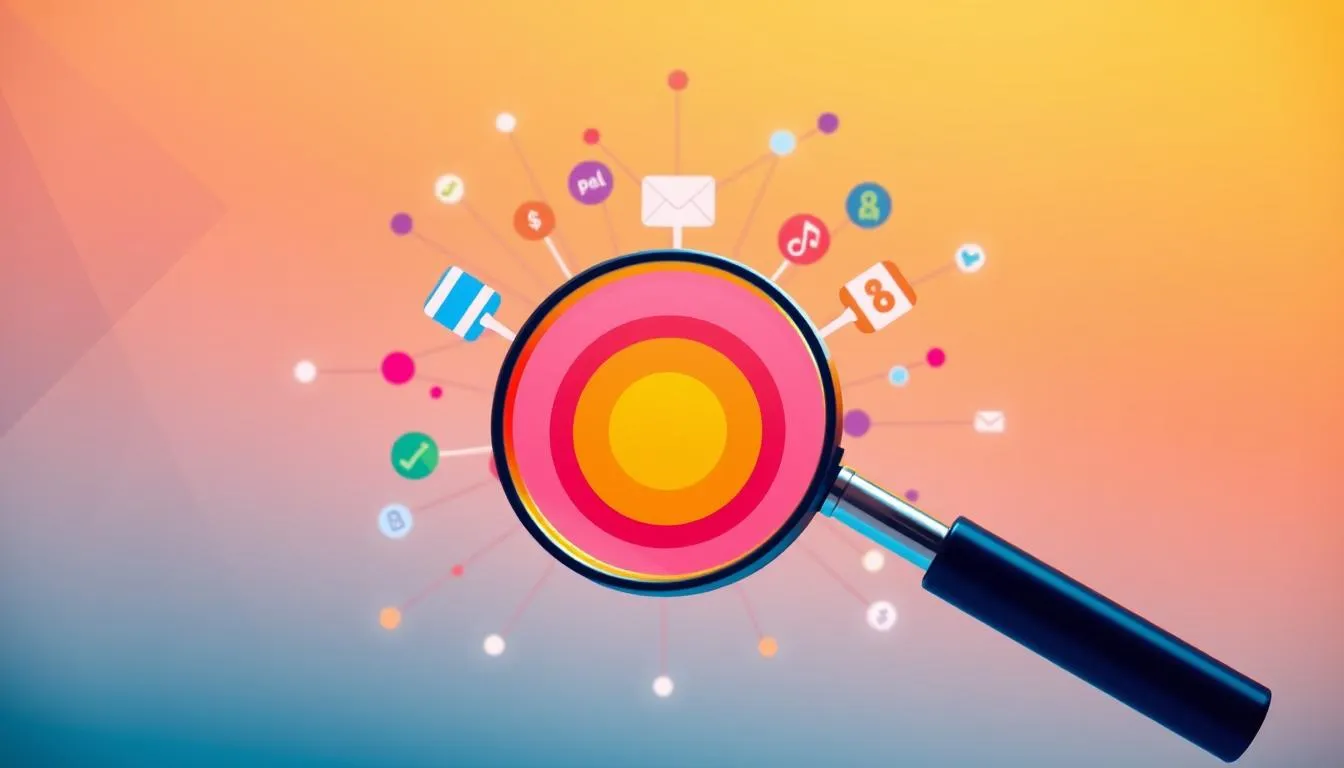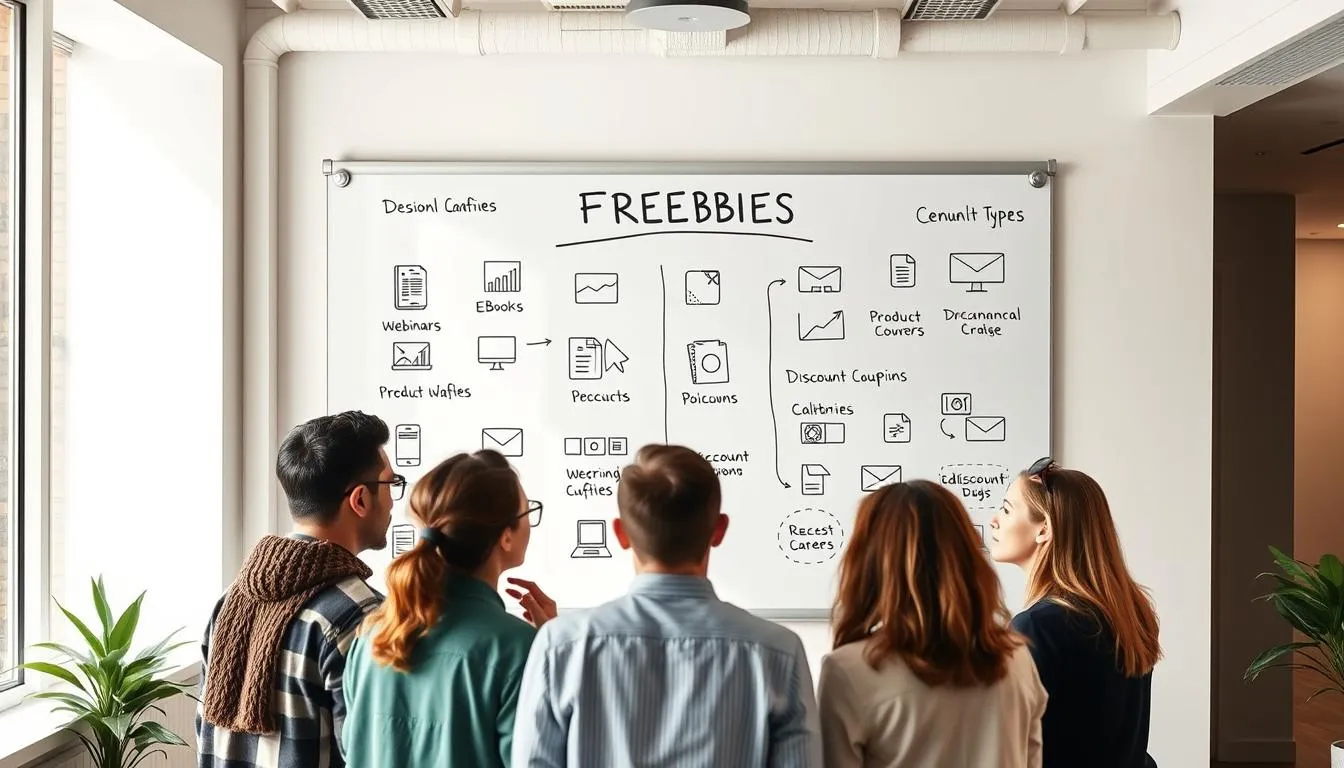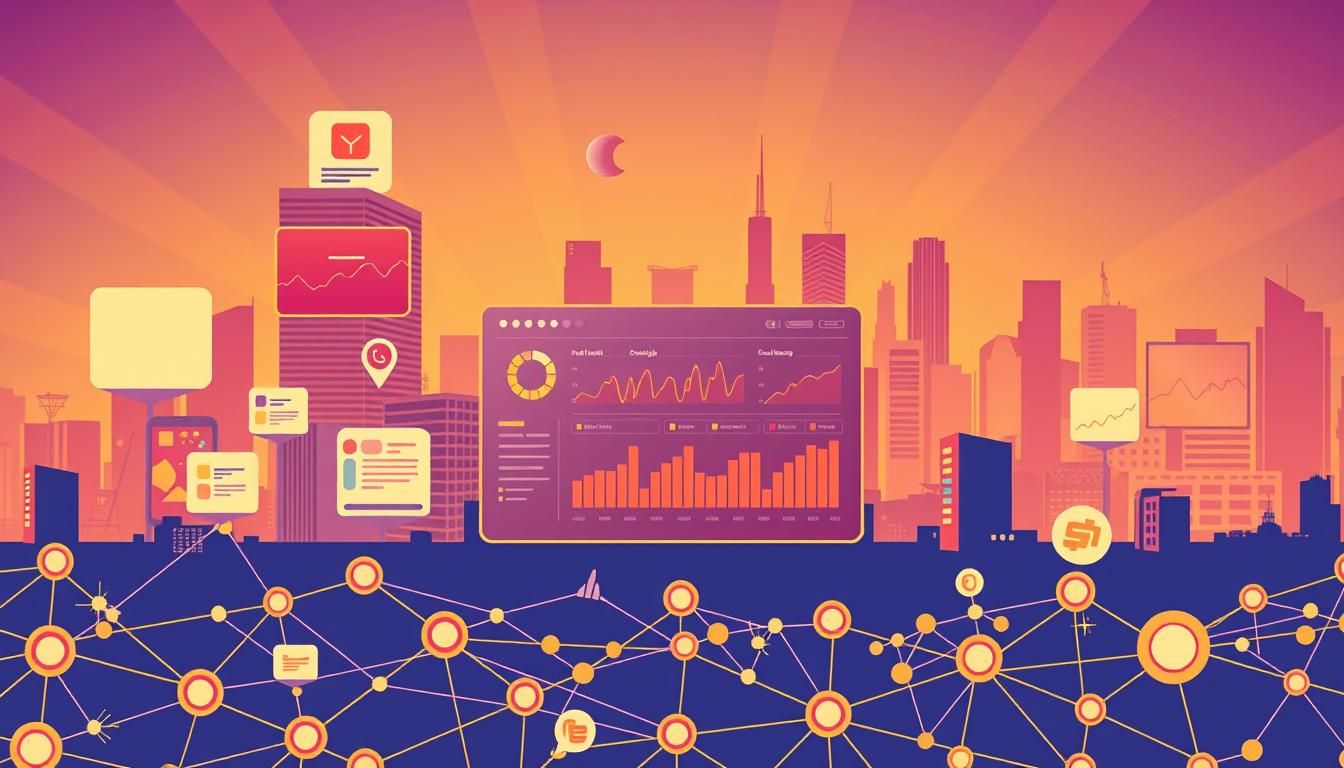Surprising fact: 72% of buyers say a useful resource makes them remember a brand later, so an upfront offer can change casual visitors into prospects fast.
This guide shows how to build a simple lead generation strategy that trades a helpful asset for contact information. You’ll learn to pick the best format—ebook, checklist, webinar, or trial—and package it to match your target audience.
Think of the process as an honest exchange. People give an email or small details when the content solves a real pain. That low friction proves expertise and warms them to your business before a sale.
We’ll set clear goals, design a landing page with an email wall, promote across channels, and measure success: landing conversion, email engagement, and sales. By treating this as a repeatable generation strategy, you compound results over time.
Key Takeaways
- Offer value first to turn strangers into prospects.
- Choose a format that fits your target audience’s pain points.
- Use a clean landing page to collect email and minimal information.
- Track conversion and engagement to validate your strategy.
- Treat the process as repeatable and refine offers for better results.
Why lead gen via freebies works for modern businesses
Giving something useful first is one of the clearest ways to earn attention and trust. It fits modern marketing because people expect helpful content before they commit. Digital offers pull prospects through social media, search, and email forms and then move them into nurturing sequences.

Inbound vs. outbound: where freebies fit in your strategy
Inbound attracts leads from online sources and lets people opt in. This process respects privacy and makes the exchange—useful content for basic information—clear and fair.
Outbound targets existing customers with messages or retargeting. Free assets work best as an inbound tactic but can support outbound campaigns by warming contacts before a personal outreach.
Pros and cons: value, trust, and the “give away too much” risk
Benefits: Free content builds trust fast, shows value, and lowers perceived risk. Potential customers sample your expertise before paying.
Risks: If you give away too much or offer low-quality assets, you may train your audience to wait for free or devalue paid services. Expect some grab-and-go behavior and plan to segment engaged people.
“Design your exchange so the free item showcases outcomes but reserves depth or custom work for paying customers.”
Balance is practical: show frameworks and wins in the free asset, and keep deeper, customized execution behind paid tiers. Plan time and resources to produce high-quality content, and repurpose across media to scale.
| Focus | Inbound | Outbound |
|---|---|---|
| Main channels | Social media, search, email forms | Retargeting ads, direct outreach, referrals |
| Role of offers | Attract interest and capture information | Warm and re-engage existing customers |
| Risk | Freeloaders, resource time to create content | Over-contacting can annoy customers |
| Best practice | Segment by engagement and nurture active prospects | Use offers to personalize follow-up |
Pick the right freebie type for your target audience
Match format to need. If your target audience wants quick wins, offer checklists or templates they can use immediately. If they want depth, choose ebooks or white papers. When people need demonstration, run short webinars or training videos.

Lead magnets: ebooks, checklists, templates, webinars, and more
Lead magnets cover many types—ebooks, checklists, templates, case studies, quizzes, swipe files, and streaming trainings. These usually trade a PDF or streamed access for an email address, making collection of basic information and segmentation simple.
Free trials: when product access beats content
Use a free trial when hands-on use best shows product value. Trials fast-track leads into evaluation and build trust quickly.
“Limit scope or time so people get a real test but you don’t give away the whole product.”
Consultations: high-touch value for qualified prospects
Consultations work well for services that need assessment—marketing, coaching, or fitness. They surface goals and let you show fit. Because calls cost time, screen requests and reserve consultations for qualified prospects.
- Match types to needs: choose fast wins for busy audiences, depth for research-minded people, or webinars when you must show process.
- Clarify data exchange: most magnets trade a PDF or video stream for an email and basic segmentation details.
- Control trials: set clear limits on duration or features to avoid giving away everything.
- Plan resource costs: use forms to screen consultation requests so calendar time goes to potential customers.
- Repurpose: turn a webinar into a checklist and a summary PDF to reach different audience preferences.
For more tactical examples and distribution tips, see this practical guide to offer free assets that convert.
Map your audience, promise a result, and scope your offer
Start by mapping what truly pains your audience and link each problem to a slim, fast solution.
Define 3–5 urgent problems your target audience faces and pick the format that delivers the quickest perceived win. Promise a clear outcome in the title and explain what people will achieve and in what time frame.

Match pain points to freebie formats and delivery
- List top pains and pair each with a format: checklist, short video, or mini audit.
- Keep the asset focused so it solves one part of the journey and points to the next step.
- Ask one or two smart segmentation questions to collect useful information without friction.
Create urgency and exclusivity without devaluing your product
Use ethical scarcity: limited spots, capped consultation slots, or a short download window. That pushes action without discounting your services.
| Pain point | Quick format | Promise (time) | Segment field |
|---|---|---|---|
| Low conversions | Checklist + mini audit | Improve CTA in 1 week | Role |
| Onboarding churn | Short video guide | Reduce churn in 14 days | Use case |
| Unknown ROI | Template + calculator | Estimate ROI in 1 session | Company size |
Document this generation strategy so you can route new leads into tailored nurture tracks for better conversion and happier customers.
Build and package your freebie so it’s irresistible
Treat the asset as a mini product: set a clear outcome, tidy layout, and a short path to action. High-quality, skimmable content improves usability and perceived value and helps your audience act fast.
The best assets use short sections, descriptive headings, and bullet lists so busy readers find what matters in seconds.
Skimmable, high-utility content that showcases your expertise
Show, don’t tell. Include frameworks, quick examples, and a step-by-step checklist people can implement the same day.
Add credibility boosters: a brief author bio, one-sentence case snapshots, and a data point that supports your approach.
Design and format: clean PDFs, video trainings, or tool-based assets
Choose the format that fits the promise: clean PDFs for quick wins, short video trainings for walkthroughs, or lightweight tool-based assets that speed execution.
- Create a skimmable structure with headings and action items.
- Use no-design tools or one platform to turn outlines into polished PDFs when resources are limited.
- Host assets on your website so pages load fast and work on mobile.
“Offer access that feels premium: tight editing and thoughtful visuals increase perceived value.”
End every asset with a clear “what to do next” that points to your product or service without pushing a hard pitch. That gentle path turns useful content into measurable generation results for your business.
Design a conversion-focused landing page and email wall
A conversion-first landing page turns a casual visitor into a subscriber with one clear action. Lead with a crisp headline that states the outcome and the time to value. For comprehensive guidance on creating high-converting landing pages, explore our ultimate guide to landing page lead magnets. Add a short subhead that clarifies who the asset helps and what’s inside.
Clear value proposition, minimal friction, standout CTA
Keep the form tiny. Collect an email and one smart segmentation field (role or use case). This reduces abandonment and keeps the exchange fair.
Put a single bold CTA above the fold. Repeat it after proof points or benefit bullets. Remove page navigation to reduce exits.
Mobile-first layout and A/B tests to lift conversion rate
Build mobile-first. Test tap targets, font sizes, and load speed. Compress images and trim scripts so the page loads fast on phones.
Run A/B tests on headlines, hero images, and CTA text to lift conversion over time.
Data you should collect: email plus smart, minimal segmentation
Ask for the minimum information you need to personalize follow-ups. Route sign-ups to a segmented list and send an instant confirmation email with next steps.
Use trusted tools like opt-in forms and email walls to gate the asset and deliver it automatically. Decktopus-style gating shows an email wall first and then opens content, which can increase list growth.
“A simple, honest exchange and a fast delivery process build trust and higher conversion.”
- Make sure benefit bullets are scannable and include a small visual preview.
- Address FAQs and privacy near the form so users know what information you’ll send and how often.
Promote across social media and partner channels to maximize reach
Promote your asset where your audience already spends time to turn exposure into measurable signups.
Start with owned channels: feature the offer on your website homepage and on related pages. Announce the launch to your email list to re-engage past contacts and convert warm traffic quickly.
Owned channels and one platform you can scale
Pick one platform you can scale and focus resources there. Concentrate on the community that matches your audience and post native content that teases the outcome.
Social media distribution and referral mechanics
Create short videos, carousels, or threads that show a quick win and link to the gated asset. Use referral mechanics to tap network effects—reward shares with bonus content, small upgrades, or recognition.
“A simple referral reward can turn satisfied users into active promoters.”
Examples to emulate
Borrow tactics from proven examples: HubSpot ran a social contest for event tickets. Trello and Dropbox used referral incentives that rewarded users. Birchbox used quizzes to personalize recommendations, and Hootsuite drove signups with contest-style promotions.
- Co-marketing: partner with complementary businesses or creators for guest posts, swaps, or joint webinars.
- Repurpose: turn key insights into visual posts and short clips to meet people where they scroll.
- Paid layer: add paid ads and remarketing once organic posts show traction to scale efficiently.
| Channel | Primary tactic | Key KPI |
|---|---|---|
| Website | Homepage banner + relevant page CTAs | Conversion rate from page visits |
| Announcement + segmented resend | Open and click-to-signup rate | |
| One platform (social) | Native posts, short videos, referral prompts | Engagement and referral-driven signups |
| Partners & Creators | Co-marketing swaps, webinars, guest posts | New audience signups and cost per acquisition |
Track channel-level performance and double down on the ways that consistently bring qualified leads. Use lookalike targeting and remarketing to maximize return as you scale.
Nurture, score, and convert your new leads
After a signup, the real work begins: guide new subscribers toward outcomes that build trust and readiness. A clear follow-up plan delivers value first and saves sales time later.
Follow-up sequences that provide value before the pitch
Build a value-first sequence: send a welcome message, a quick-start guide, and two to three actionable tips tied to the original asset. To enhance your email marketing strategy and audience engagement, consider implementing cross-promotion techniques with niche newsletters. Keep each message short and useful.
Personalize based on the segmentation data collected at signup and on behavior—clicks, replay views, and topic interest. That improves relevance and opens doors to conversation.
- Include case snapshots that mirror the subscriber’s context.
- Offer a consult or demo only after clear engagement signals.
- Respect inbox time: set expectations for cadence and provide preference options.
Lead scoring and segmenting based on interest and behavior
Implement a scoring model that weighs recency, frequency, and action depth. Focus sales outreach on the most ready users and route others into learning tracks.
“Measure conversion from subscriber to customer to understand quality and improve the process.”
| Signal | Weight | Action |
|---|---|---|
| Email open + click | 3 | Send targeted tip |
| Replay view or resource download | 4 | Invite to demo |
| Request for pricing or trial | 5 | Assign to sales |
Close the loop: track reply rates, bookings, trial activations, and purchases. Feed findings back into your list and product so each cohort gets smarter, faster results.
Conclusion
Finish strong: measure what works, keep offers tight, and iterate quickly.
Recap the path: define the problem, choose a freebie that fits your target audience, package it well, ship a focused landing page, promote with intent, and nurture people into customers.
Balance value and scarcity: give away meaningful content that solves one part of the journey and invites the next paid step. Consider transforming your most successful lead magnets into comprehensive courses using our blog to course transformation blueprint.
Track the right numbers: leads generated, landing page conversion rate, cost per lead, email engagement, and how many people become customers.
Use insights to refine your strategy—what resonated, where people dropped off, and which tools or one platform worked best.
Act now: pick one freebie idea, outline the content and tools, and schedule production this week. For practical steps on turning giveaways into real sales, see this practical guide.
Confidence close: when you generate leads with a precise, relevant offer, you build trust, shorten evaluation time, and create marketing leverage that turns potential customers into paying customers.
FAQ
What types of giveaways convert best for small businesses?
Short, high-utility items work well: checklists, templates, and one-hour webinars that solve a specific pain. Free trials and consultations convert when your product or service needs hands-on experience. Match the format to the audience and the stage in the funnel.
How do I choose the right audience for an offer?
Start by mapping customer pain points and desired outcomes. Use surveys, website analytics, and social listening to find intent signals. Build one buyer persona and tailor the promise to that persona before scaling to others.
Which channels should I use to promote an offer?
Focus on owned channels first: your website, email list, and one social platform where your audience already spends time. Then add partnerships, referral programs, and targeted social ads to expand reach.
What information should I collect on the signup form?
Collect email plus one smart field for segmentation, such as industry or role. Keep friction low—ask less to increase conversions—and use progressive profiling later to gather details over time.
How do I avoid giving away too much value for free?
Deliver practical, usable content that solves a single problem but leaves space for deeper work. Use gated templates or intro trainings that demonstrate expertise while reserving premium features for paid plans or paid services.
How can I craft a landing page that converts?
Use a clear value proposition, social proof, a single standout CTA, and minimal form fields. Optimize for mobile, test headline and CTA variations, and remove distractions like extra links that pull users away.
What metrics should I track after someone signs up?
Track conversion rate on the landing page, email open and click rates, time to first engagement, and downstream conversion to paid offers. Use behavioral data to score and segment prospects for follow-up.
How do I nurture prospects without annoying them?
Send a short, value-first sequence: delivery email, follow-up with actionable tips, and a helpful case study. Space messages to give time for action and include clear unsubscribe options to respect inboxes.
When is a free consultation better than a downloadable asset?
Offer consultations when your sales cycle is complex and personalized advice shortens the decision process. Use consults to qualify high-intent prospects and gather information that speeds conversion.
Can partnerships and referrals scale my acquisition?
Yes. Partner channels and referral mechanics tap audiences you don’t own and can amplify reach cost-effectively. Structure incentives clearly and co-promote with aligned brands like HubSpot or Hootsuite for credible lift.
How often should I A/B test my offer and pages?
Test continuously but focus on one variable at a time: headline, CTA, image, or form length. Run tests long enough to reach statistical significance—usually a few weeks depending on traffic—and iterate on winners.
What tools do I need to run this process?
Use a landing page builder, email platform, analytics, and a simple CRM for segmentation and scoring. Popular choices include Mailchimp, HubSpot, and Google Analytics. Pick tools that integrate to reduce manual work.
